FINDING THE CAMERONS
Finding
the ancestors of Alexander Cameron has been challenging
because he is quite mobile, and not attached to a particular
farm or parish. He was born in Strontian, married in
Kilmelfort, had children in Kilmelfort, then Kilbrandon, then
Inishail. Ten years later, the Camerons were in Inveraray.
They continued here, and Alexander may have died here.
Extensive research has been undertaken to locate his father,
John Cameron, and the details are available here: Cameron
Research.
Alexander's father, John Cameron, was shown as being "of Mull" in Cameron family records, and had at least one child (Alexander) born in Strontian. There is also a cryptic reference in family records to Black Cairn. John Cameron is a very common name in that area, and it is hard to identify our John. His wife's name is not known for sure. The names of his children and their birth order is known, but their births pre-date the parish register.
John Cameron born abt. 1769 of Mull
Mrs. John Cameron " " 1771 "
Children:
Donald 1791 of Mull
Peter 1793 "
John 1795 "
*Alexander 1797 "
Thomas 1799 "
Jennet 1801 "
Kirtsey 1803 "
(Temple Record Book of Catherine Cameron Southam, FHS# 218887)
The birth years of John's children are obviously calculated, and spaced about two years apart. They are most likely calculated from Alexander's birth year, as that was known and recorded by his son John Alexander. Alexander's father John's birth year seems to be calculated, too. His wife's birth year was shown as twenty years before the birth of the first child. John's birth year was two years before that, making his calculated birth year 1769 of Mull. He would have been 21 years old at his calculated marriage date of 1790.
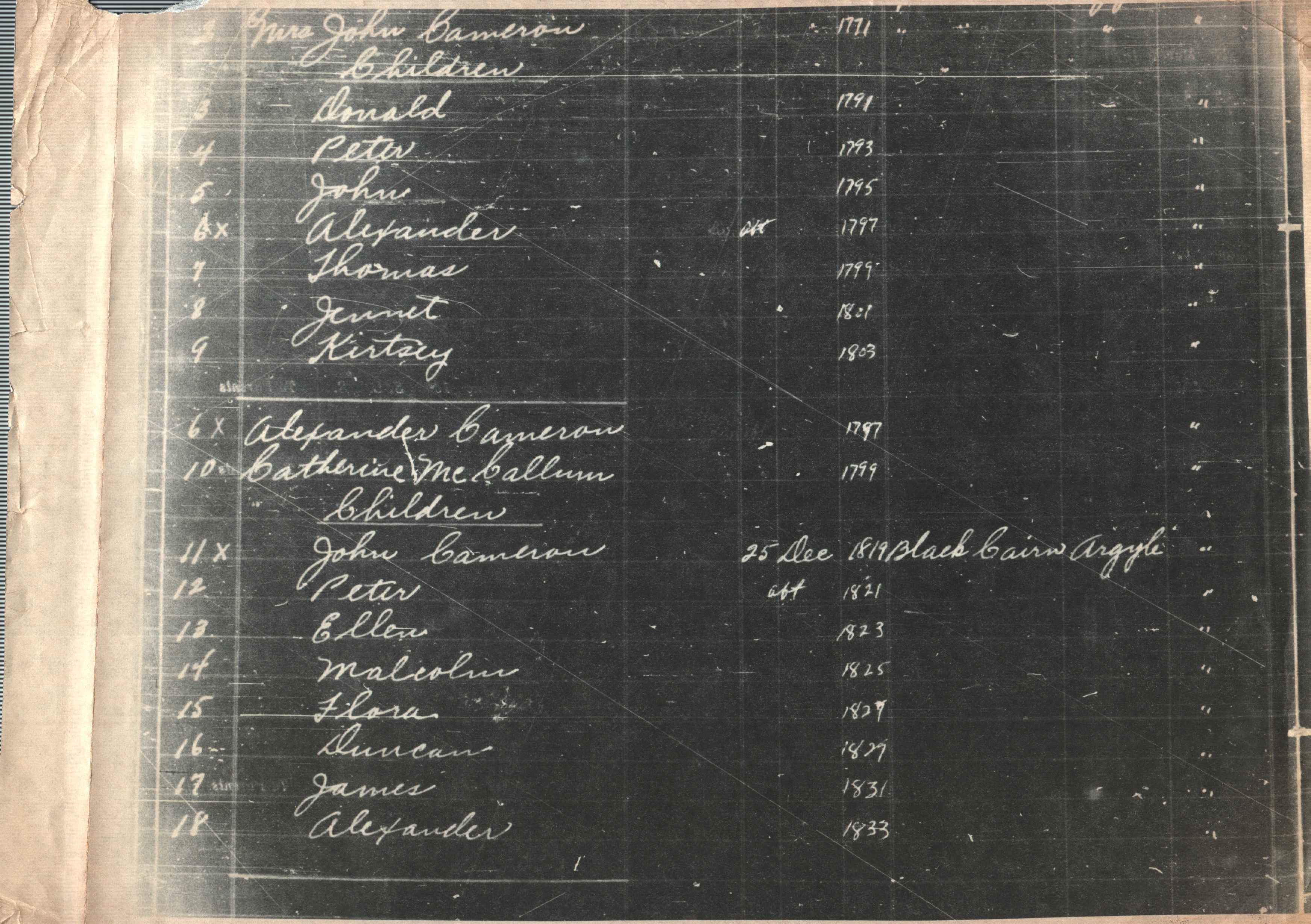
Record Book of Catherine Cameron Southam, granddaughter of Alexander Cameron
Only five John Camerons were found on Mull in the 1779 census. Only one had an age close to the calculated age in the Record Book of Catherine Cameron Southam - John Cameron of Auchnacraig, who was eighteen years old, born just eight years before the calculated date. He would have been 29 years old at his calculated marriage date of 1790.
These John Camerons were listed on the 1779 census:
Inhabitants of the Argyll Estate 1779
Knocknafennaig
John Cameron age 64
His wife and daughters, 3
John Cameron junior age 35
His son Hugh 8
His wife
This family in Knocknafenaig is well-documented, and later emigrated to Canada. They had roots in the Mull area, and a John Cameron was listed in Knocknafenaig in 1716. "It is interesting to note the continued presence of another uncommon Mull name at Knocknafenaig. Two Cameron families also resided there. They were descendants of the Cameron who was listed on the 1716 Disarming List at Knocknafeig. John Cameron, 64 lived there with his wife and three year old son." (The Naked Clansman, by Ian McPhee) The three year-old son was named Hugh, and appears in later records. "Most of the Knocknafenaig people left in the 1850s, and again in 1865, for Bruce County Ontario, where Camerons can be identified in the Port Elgin cemetery." (Mull Family Names for Ancestor Hunters; Jo Currie)
Icolmkiln
Angus Cameron tenant age 74
His son John Cameron age 28
His wife, daughter and servant
Neil Cameron tenant age 35
His son Colin Cameron age 6
His wife, daughter and mother 3
This John Cameron was born in 1751, too old to be our John.
Achnacraig
John Cameron age 18
John Cameron age 64
The young John Cameron is the most likely candidate for our John Cameron, He was born in 1761. John lived in the hamlet of Auchnacraig, on the east coast of Mull, near the ferry crossing. The Camerons were not in Auchnacraig in 1716, but appear in time for the 1779 census. Local histories say that they were likely from the Cameron lands in Lochaber in the years after the Jacobite rebellion in 1745-6. This John did not stay and marry and have children in Mull. The little hamlet of Auchnacraig was in the parish of Torosay. The only other Cameron in the hamlet was another John Cameron, age 64, who is likely John's father. The senior John would have been born in 1715. This would have made him about thirty years old at the time of the Jacobite rebellion, and of an age to have fought with the Camerons. This is in agreement with the statement on the Camerons in Mull: ""Cameron, like McPhie, was a surname rarely found on Mull or Iona. The name became more common after the Jacobite defeat at Culloden, when several Cameron families who had supported the Jacobite cause moved from their clan area of Lochaber to Mull and Iona.” There is a family tradition that the knife (sgian dhu) John Alexander Cameron brought with him to America was used in the battle of Culloden in 1746. Was it his great-grandfather John Cameron's knife? After Culloden many Camerons lost their land. Their clan chief Cameron of Lochiel did not regain his land until 1784. Perhaps John senior was driven from his home after Culloden, and came to Mull, where his son John was born in 1761.
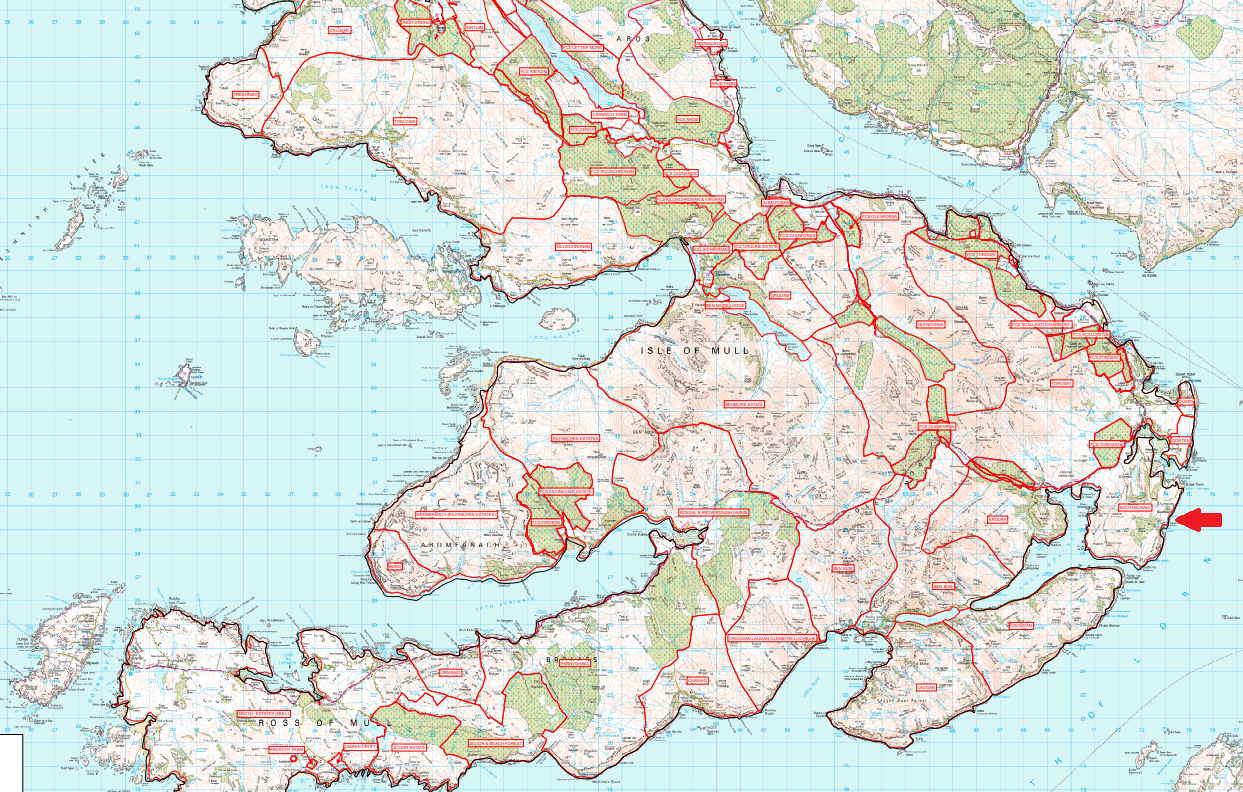
Map of the Isle of Mull, with the red arrow showing the location of Auchnacraig
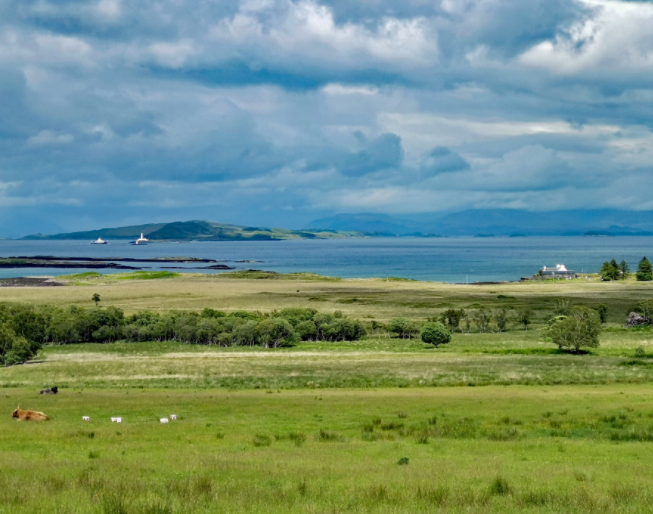
Auchnacraig
John Cameron was born in Mull, most likely in 1761 in Auchnacraig, Torosay parish, Isle of Mull, Scotland, the son of John Cameron. He moved to Strontian, Argyllshire by 1797, probably to work in the lead mines.
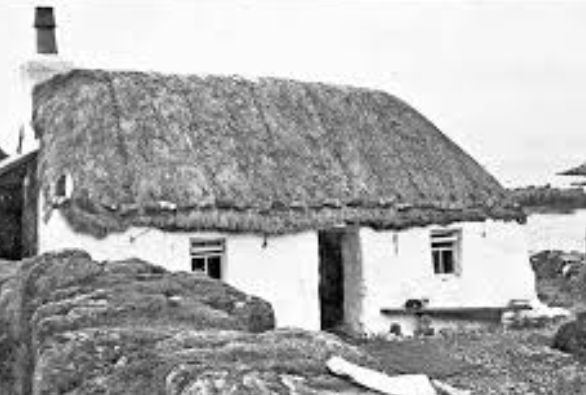
Mull cottage
Auchnacraig was a hamlet near the ferry from the mainland: "The ferry from Achnacraig to Mull to Kerrera belonged to the Duke (of Argyll) and was in tack to Angus Gregorson or MacGregor, who enjoyed a monopoloy of the transport of cattle to the mainland. The Duke’s tenants in Mull were obliged by their leases to use the ferry." The tacksman in charge of the farm at Auchnacraig was John Gregorson: "Perhaps the most characteristic figure is John Gregorson, who had a tack of Auchnacraig and Ardchyle in Mull, with the inn at Auchnacraig, in the 3rd and 4th Dukes’ time. He acquired ‘the exclusive privilege to ferry cattell and passengers from Torosay to the continent of Lorn'. His brother Angus succeeded him in this tack and his monopoly of the ferry. (Book of Mull and Morvern Tacks, 1770-1776; Remarks on the Estate of Mull and Morvern, unsigned report, dated 1771, at Inveraray Castle) In this location, John and his son John likely farmed the land, worked with the ferry, or fished for a living. Auchnacraig is mentioned as a farm in letters from the Duke of Argyll: "The improvements executed upon the farms of Achnacraig, Achadashinaig, Fidden and Ardtorinish in terms of the tacksmen’s prorogated leased, have been inspected by the chamberlain and a relative report of the state of their progress is herewith laid before my Lord Duke." (Book of Mull and Morvern Tacks) The Duke of Argyll was the landowner for a large part of Argyllshire, including Mull and Morvern, with Strontian, Sunart and Ardnamurchan included. He left careful instructions for the stewards in all of his estates, which includes some mention of its tenants. John Cameron's ancestors of Mull and Strontian were likely his tenants.
Auchnacraig was a small hamlet, and the 1779 census listed 84 inhabitants.
Dugald McLachlan, age 56
James Bonnar, age 20
Hugh McLachlan, age 22
John McLachlan, age 16
Robert McLachlan age 14
Alan McLachlan, age 11
Alexr McLachlan, age 12
John McGregor, age 20, ferryman
Allan McDonald, age 30
Donald McLachlan, age 28
Angus McLachlan, age 22, servant
Donald McLugas, 10
Dugald McLachlan, age 9
Dugald McLachlan, age 10
Archibald McLugas, age 35
John McLugas, age 8
John Carmichael, age 20
John McLachlan, age 32
John Cameron, age 18
Duncan McLachlan, age 3
Andrew McLachlan, age 0
John Cameron, age 64
John Fletcher, age 50
Lachlan McLachlan, age 58
Hugh McLachlan, age 15
Archibald McLucash, age 45
Duncan McLucash, age 6
Archibald McLucash, age 4
Donald McLucash, age 2
John McGrigor, age 50
Angus Fletcher, age 8
John McLachlan, age 25
John Colquhoun, age 7
50 females
Only the males were listed in the census by name. There were seven different surnames listed, and probably about ten households. The women and girls were only listed as a total number of 50 females. All males were listed by name, including children. There were 19 adult males of 16 years or older. Occupations were only listed for two of the men - a ferryman and a servant. The others may have been farming or fishing. Only one McDonald had been listed in the earlier 1716 census in Auchnacraig, with one McLugash in the nearby hamlet of Glennan. The other families were not there at that time, and may have come later. The families listed in Auchnacraig in 1716 were McDugald, Lamont, McLean, McIlvorie, McDonald, McInnish, McChannanich, McKiachan, and McLea.
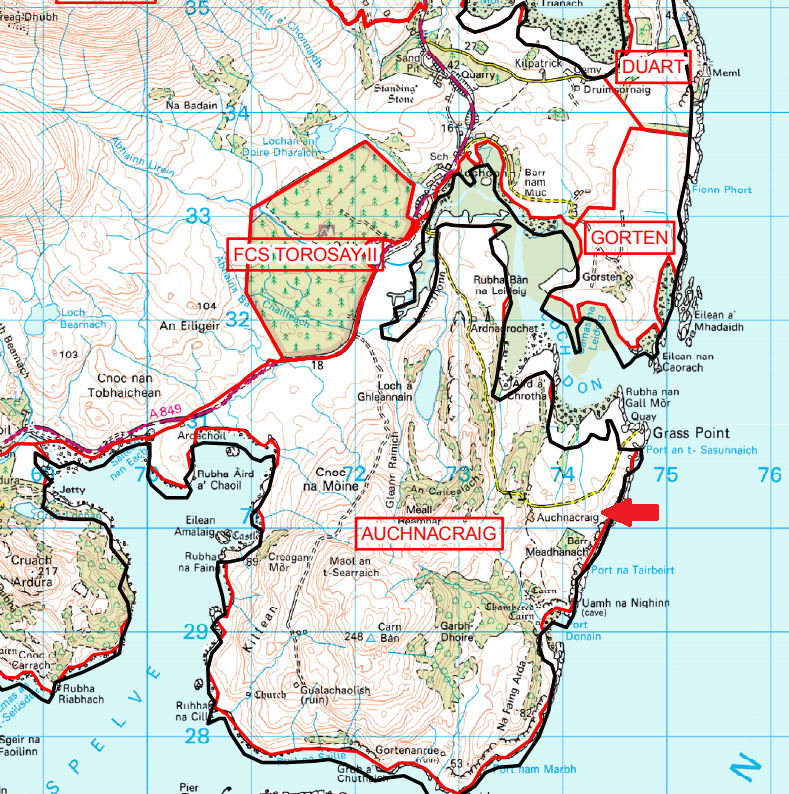
Map of the Auchnacraig estate, showing the hamlet of Auchnacraig on the coast
Unfortunately John's mother was not named on the list. One other Cameron was listed as being of Auchnacraig in later baptism records - Catherine Cameron of Auchnacraig who married Lachlan McLachlan, and had ten children baptised in the parish, beginning in 1794. She is likely a sister to John Cameron.
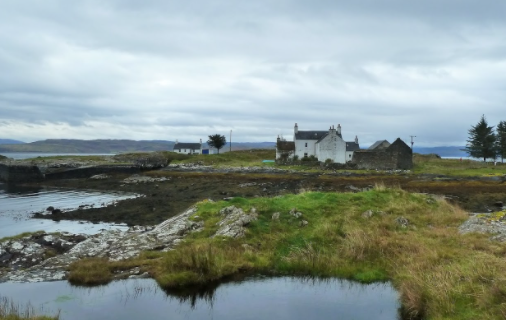
Ferry Cottage at Grass Point near Auchnacraig
What happened to young John Cameron? There is no record of his marriage or baptisms of children in the Torosay parish register. We know that our John Cameron of Mull, must have left the island, and his son Alexander was born in Strontian on the mainland in 1797. Strontian was a lead mining village. The economy on Mull was challenging, and John may have moved to Strontian to work in the lead mines. No record was found for his children's baptisms in Mull where the parish records began in 1790, and the Strontian parish registers don't begin until 1804, so the children were probably born in Strontian starting in 1791 and continuing until 1803. Alexander Cameron identified Strontian as his birthplace on the 1861 census.
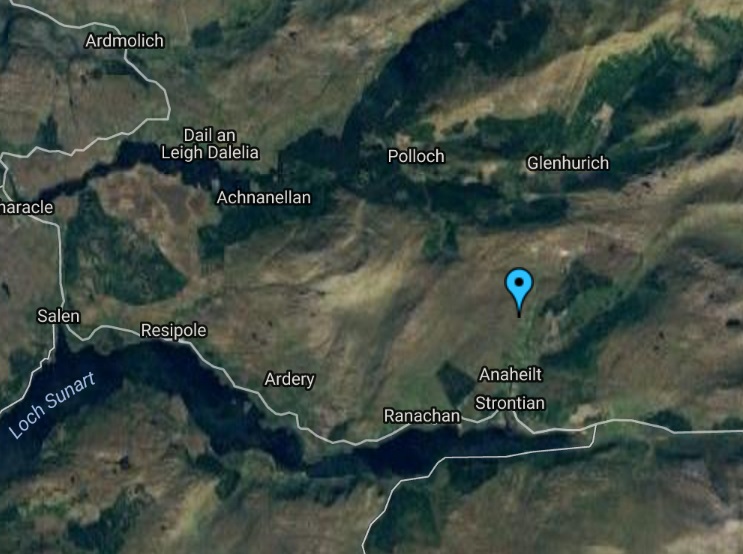
Map of Strontian parish
Separate parish registers exist for Strontian beginning in 1804. Ardnamurchan parish registers exist from 1777, but are blank from January 1779 to May 1802, and April 1809 to May 1810. No burials are recorded in the early parish registers, but baptisms and marriages are recorded. John Cameron's last child was Kirtsey, born about 1803, one year before the Strontian parish register begins. There were a large number of Camerons in Strontian. For example, in 1806, there were 31 baptisms listed in the Strontian parish register. Of these 19 (or 61%) were children born to Cameron fathers. There are 16 different John Cameron families in Strontian having children baptized between 1804 and 1810. After an exhaustive search, no baptismal records have been found that closely match John Cameron's family. To review the parish registers results, click here: Cameron Research.
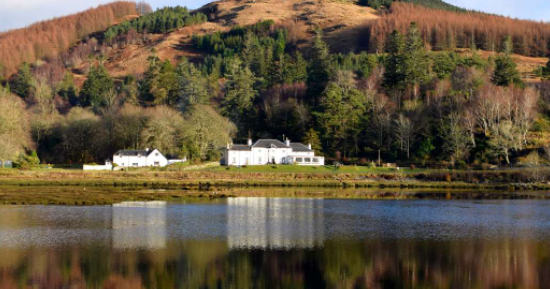
Strontian
Strontian is a village and parish in highland Scotland, in the county of Argyllshire, The main industry in the parish was lead mining, which began in 1725. In these mines the mineral strontianite was discoved. The community was built out to provide housing for the lead miners. In 1871, the population of Strontian was 803. Anaheilt, Ramachan, and Scotstown are hamlets and considered part of Strontian. Anaheilt had eight families in 1723, which had grown to 28 crofts by 1828. Many of the families of Strontian were Camerons, and most worked in the lead mines.
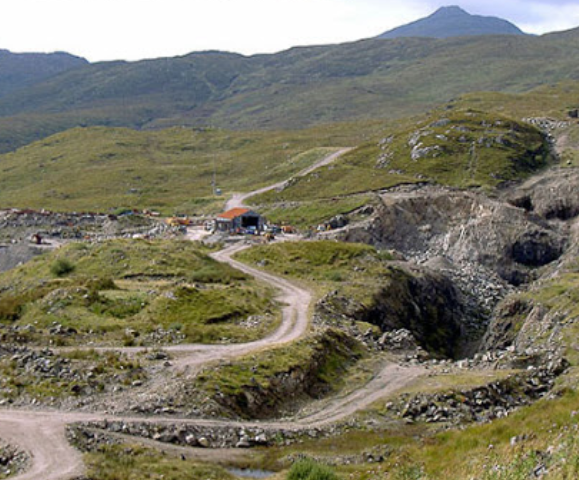
Strontian mine
John and his wife had the following children, most likely born in Strontian before 1804:
1. Donald, born in about 1791in Strontian.
2. Peter, born in about 1793 in Strontian.
3. John, born in about 1795 in Stontian.
*4. Alexander, born in 1797 in Strontian, Argyllshire, Scotland; married Catherine MacCallum 9 December 1813 in Kilmelford, Argyllshire.
5. Thomas, born in about 1799 of Strontian.
6. Jennet, born in about 1801 of Strontian.
7. Kirtsey, born in about 1803 of Strontian.
SOURCES: Catherine Cameron Southam, Temple Record Book; 1861 Scottish census, Inveraray; Inhabitants of the Argyll Estate 1799; The Naked Clansmen on Mull & Iona, by Ian McPhee; Strontian parish register.
John Cameron was born in about 1715. Local histories of Mull suggest that he was one of the Camerons who came to Mull after the Jacobite rebellion (about 1746). John may have come from the Cameron lands of Lochaber in norther Argyllshire and Inverness-shire, or from the lands of Ardnamurchan, Sunart and Morvern in Argyllshire. According to clancameron.org, Clan Cameron Cadet Families: “The Camerons of Ardnamurchan, along with the Camerons of Sunart and Morvern, these Camerons are descended from Donald na Cuirc Cameron of Glendessary, son of Allan M’Illduy of Lochiel and other affiliated Camerons, who in or about 1650 secured tacks of large areas in these districts and “colonized” them with Cameron clansmen. In addition to Camerons there were also a fair number of MacMillans, MacPhees and MacLachlans.” It is interesting that the MacLachlans were so well-represented in Auchnacraig, and the McPhees are also found on Mull.
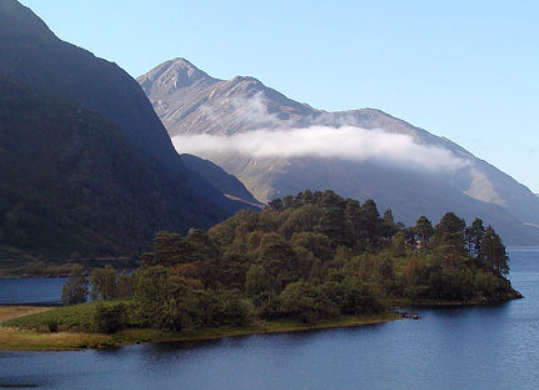
Lochaber, home of the Camerons
"Cameron country is
traditionally in the mainland areas of southwest
Inverness-shire, and north mainland Argyll, but it is
interesting that Blacu's published map of Mull identifies
the island as one which "lyeth ovir against Lochaber". To
Timothy Pont, the minister who supplied most of the
topographic information for Blacu's map, Lochaber, home of
the Camerons was a hop, skip and jump from Mull in
the days when all communications were by sea, and many Camerons
must have hopped from Lochaber and Morvern to Mull in
the 18th century, mainly after the Jacobite rebellion in
which so many Camerons played a part." (Mull Family
Names for Ancestor Hunters; Jo Currie)
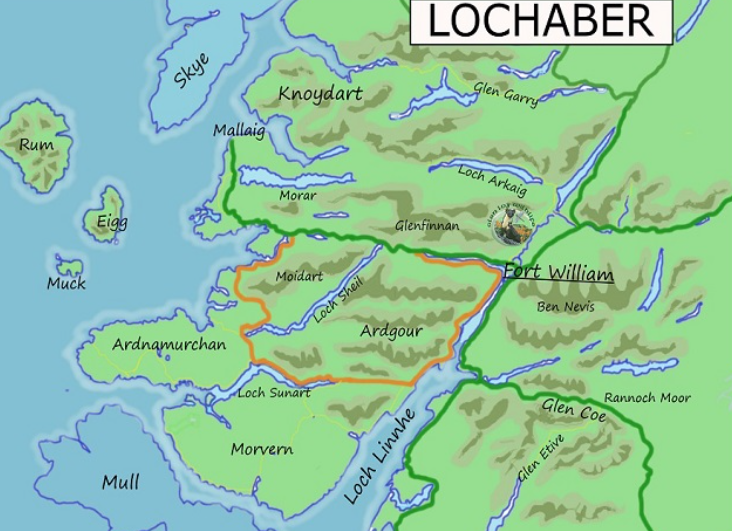
Map of Lochaber
John would
have been about thirty years old at the time of the Jacobite
rebellion (1745-6). Approximately 700 Cameron men fought in
the battle of Culloden, and over half of them died. "The
Battle of Culloden was a defining moment in Highland
history. James Francis Stuart, the Old Pretender, who had
failed in his attempt to regain the English throne in 1715,
had a son called Charles Edward Stuart. His good looks and
personality had given rise to his nickname of Bonnie Prince
Charlie. Like his father, he also coveted the English
throne...Bonnie Prince Charlies's campaign to seize the
English throne began when he landed in the north of Scotland
during 1745 and gained the support of numerous Highland
clans. Among them was the powerful Cameron Clan, loyal to
the Cameron Clan Chief known as Lochiel." (The Naked
Clansmen, McPhee)
These fifteen John Camerons fought in the Battle of Culloden. Of these, five died or were transported, so could not be our John Cameron. If he did fight in Culloden, he could be one of these ten remaining John Camerons.
The names of
the Jacobite soldiers who were in Donald Cameron of
Lochiel's regiment during the Jacobite rising of 1745 were:
Captains
John Cameron, excaped
Officers
John Cameron (Argyll), brother to Callart, died of wounds at Culloden
John Cameron (Chelsea Pensioner), uncle to Reverend John, escaped
Chaplains
Rev. John Cameron (Fort William, Church of Scotland Minister),Reverend, Fort William, Church of Scotland
Sergeants
John Cameron (Corpach, Brewer)
Private men
John Cameron (Lochaber, Labourer), surrendered 24 May 1746
John Cameron (Lochaber, Labourer, 70), taken at Carlisle, transported
John Cameron (Lochaber, Labourer, 60), taken at Carlisle, transported
John Cameron (Auchnacarry, Lochaber), surrendered 24 May 1746
John Cameron (Argyllshire), wounded at Prestonpans, taken prisoner, died
John Cameron Rae (Lochaber), surrendered 24 May 1746
John Cameron (Corran, Lochaber)
John Cameron (Lochaber, Labourer, 33), deserted, taken 6 November 1745, transported
John Cameron (Stroan, Lochaber), surrendered 24 May 1746
John Cameron (Strontian, Whisky maker), deserted, pardoned 1747: Cameron, John, from Strontian, imprisoned Edinburgh Tolbooth, released under General Pardon, 1747, "A whiskie maker in Strontian. Confesses that he marched with the rebels to Lauder and made his escape from there. Denies he carried arms.
(SOURCES: No Quarter Given, edited by Alastair Livingstone, Christian W.H. Aikman, and Berry Stuart Hart; Jacobite Rebellion of 1745, Regimental Lists, jacobites.net; https://military.wikia.org/wiki/Donald_Cameron_of_Lochiel; Highland Jacobites, Frances McDonnell)
"The Camerons, Stewarts of Appin and the Athollmen made up the right flank's first line. The men of Atholl were positioned on the far right "with their flank resting on the dry-stone wall of the Culwhinia enclosure." Between them and the Stewarts was Lochiel's regiment. A reported 700 men, mainly from Lochaber, were there in Lochiel's formation, mostly consisting of Camerons but also known to include a few men from at least the following clans and septs: Fraser, Grants, MacDonald, MacDougall, MacHoule, MacKenzie, MacLachlan, MacLeod, MacMartin, MacMillan, MacNeill, MacOllonie, MacPhee and even a few men from Clan Campbell. Nevertheless, this was a Clan Cameron regiment, accompanied by their septs and various tenants from Lochiel's estate...Before each clan stood the chief...With him were his henchmen and his piper, and a small bodyguard formed by two of the best men from each company of the clan. With the companies in line, captained by cadets of the chieftain's family, or by chiefs of smaller septs, were two lieutenants and two ensigns, and they, too, were chief's sons or the sons of sons. The first ranks of each company consisted of men who may have held land or had no land at all, but who were, in the geology of their society, placed among the strata of gentlemen...Behind them stood those with lesser claims to gentility, and behind again yet another rank, so that in some clans the ranks were six deep. In the rear of all stood the wild and bearded humblies...But these common men, disposed themselves by families, brothers and sons about the father, for it was in the tradition of their hills that the oldest and most respected should stand closest to the enemy, and that inspiration and courage should pass through father, brother, son, tenant and servant." (www.clan-cameron.org)
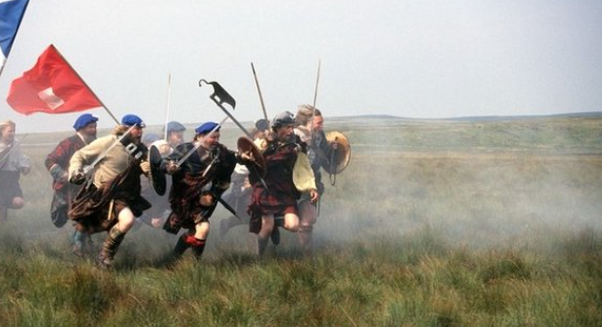
"Based upon
reported casualties of the other clans on the Jacobite right
wing it is conservatively estimated that out of the 700 Camerons
who were on the field that day approximately 225 were
killed and 150 wounded. Prisoner records indicate that
only 17 Camerons were taken from the field alive
and as prisoners. The other 133 "estimated" wounded
were bayoneted or shot where they lay, or would soon die in
confinement. From this, it may be surmised that at
least 358 Camerons, over one-half of Lochiel's
regiment, perished on Culloden Moor. Throughout the
entire Jacobite right wing's front line, the gentility of
the Highlands, hardly a man survived the charge. It is said
that the surviving Camerons were drawn to a hill
just a short way from Culloden by their piper's screaming,
desperate rant. They could see their shattered army in
full retreat all around them. These men of Lochaber
would reluctantly retreat to their native land, places that
were once safe haven from the outside world. As was
their fate at Culloden, they would soon find that nowhere in
Scotland was there a safe haven for true Highlanders."
(www.clan-cameron.org)
The defeated Highlanders returned to Locaber or the mountains: "Many of the Highlanders headed for Inverness and were hunted down and killed without mercy by Cumberland's dragoons. Others, who headed into the mountains, stood a better chance of survival, but the government troops were thorough in their retribution." (Culloden, www.bbc.co.uk)
"While Charles made his escape the full force of the Government's revenge fell upon the Highlands. After the battle wounded clansmen were put to death on Cumberland's order, which is why he acquired the nickname of 'Butcher'. Several hundred more were cut down and killed on the retreat to Inverness, and these included bystanders. Finally, the town itself was thoroughly searched and people suspected of being concerned in the rebellion were killed on the spot...The decision was taken to crush the power of the Highlanders and destroy their traditional way of living. Bland, who was a major-general in Cumberland's army, was in favour of a tough military ...Cumberland's soldiers were happy to carry out the orders of their officers in the summer of 1746, especially since it was so easy and they met little resistance. As the soldiers marched through the Great Glen they burned the huts and crofts of the clansmen and the houses of the chiefs, and committed many atrocities. The Highlanders who were captured were shipped off to the colonies like slaves, and those left found it hard to survive, because they relied on their cattle for food, and it was policy to take these. In the Highlands the '45 was also a civil war with members of several clans taking part on both sides, but military policy did not distinguish very easily between the innocent and the guilty. There were also quite difficult problems of knowing whom to punish. The Duke of Argyll was one of the government's most powerful supporters, yet his tenants in Morven were either Camerons or Macleans and most of the men had been in the Jacobite army. Morven was laid waste, and the Duke of Argyll suffered a considerable loss of revenue, for which the government was not anxious to compensate him. This sort of action fitted in well with Cumberland's belief that all Scots were rebels and traitors...The property of those who had joined the rebellion was confiscated, and the 'Forfeited Estates' were administered directly by the government in pursuit of a policy of breaking up the Highlanders' way of life. The political, military and judicial power of the clan chiefs was abolished. The Highlanders were forbidden on pain of death from wearing a tartan plaid (the kilt is the more modern equivalent), bear arms, or carry a dirk or dagger." (Treatment of the Highlanders, University of Nottingham)
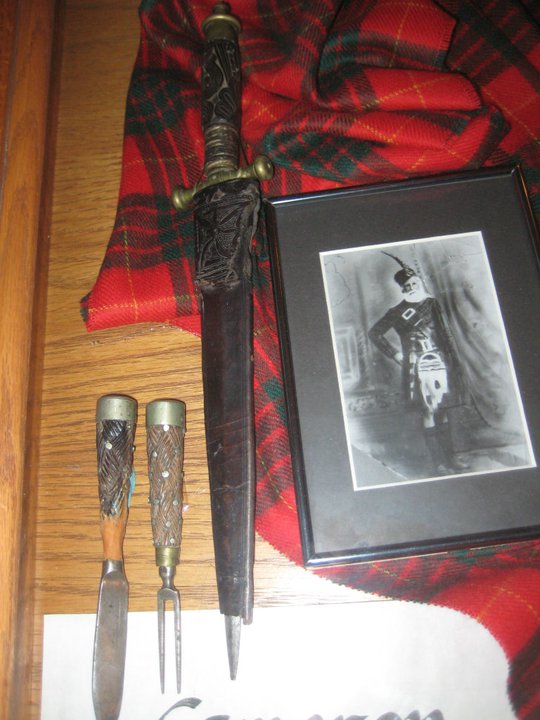
John Alexander Cameron's knife
Family tradition is that the knife was used in the Batlle of Culloden.
John Cameron senior was John Alexander Cameron's great-grandson.
A letter from Lord Albemarle discusses the problem of hidden weapons in 1746-7:“The common people such as are herried and their cattle driven, especially among the Cameron, Clanronalds, Glengarys and Glen Morisons, are all ready to espouse the smallest opportunity to appear in Arms again, and for that purpose have certainly concealed some Arms, tho’ the number cannot be determined.” *The Albemarle Papers - Being the Correspondence of William Anne, Second Earl of Albemarle, Commander in Chief in Scotland, 1746-7)
If the 31-year-old John Cameron did fight in and survive the battle of Culloden, he may have been in hiding in the years after the battle. He likely lost friends and family, and his home. His wealth, usually in cattle, would have been confiscated. Did he have a family? His clan chief was in exile. How did he manage to survive from 1746 until 1761 when his son was born in a small hamlet in Mull, some fifteen years later?
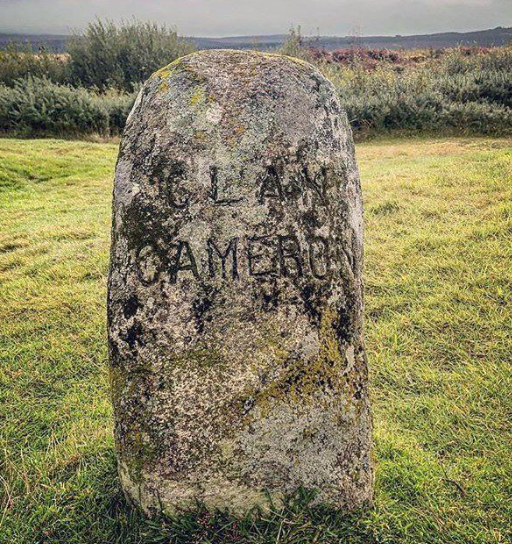
Memorial stone for the Camerons at Culloden
A tribute to the
Camerons came from an enemy commander in a letter to a friend
the day after Culloden: "They were attacked by the
Camerons (the bravest clan amongst them)." (Letter from
Captain Wolfe, No Quarter Given)
After Culloden, "The once extensive lands of the Camerons have shrunk to little more than a single farm. The MacLeans, politically not so suspect as the Camerons, retain the wide Broloss lands, but have lost a number of their farms...The Camerons did not lose their fierce, fighting spirit: In critical times, the northern districts were as much a handicap as an asset, whilst in normal times the dispossessed Camerons plundered and terrorised the tacksmen in Morvern, and Campbell of Airds, when collecting the rents, never ventured there without an armed posse." (Argyll Estate Instructions: Mull, Morvern, Tiree, 1771-1805, edited by Eric R.. Cregeen, Scottish History Society, 1964.)
Edinburgh - October 3, 1746
To distress the Clan Cameron and oblidge them to a Complyance with the present Laws against carrying of Arms, and wearing of Highland Cloathes, a Military force will be necessary.
For this purpose, and apprehending such Rebell Gentlemen as are lurking in Lochels Country, and preventing their making Depredations on their Neighbours who are Loyal Subjects, it is judged 430 men will be necessary, and to be stationed as follows:
100 at Strontian - accommodation (exists) for 200.
70 Head of Locheyll - but indifferent Quarters. Distant from Strontian 9 miles.
100 Head of Locherkaig - requires a Strong Party as Bordering on Knoydart and the McDonalds Country - bad accommodation. Distant from the head of Locheyll 6 miles.
50 Locheyls House at Achnacarry. Distant from head of Locherkaig 12 miles.
50 Highbridge - indifferent accommodation. Distant from Achnacarry 4 miles.
60 Kinlochbeg and Achtrichedan in Glencoe. Tolerable accommodation. Distant from Highbridge 12 miles.
-----------------
430
The above scheme given in by Donald Campbell of Airds to the Right Hon. the Earl of Albemarl, and the Right Hon. the Lord Justice Clerk.
[Signed] Donald Campbell
How did John Cameron come to Mull? "After the initial swift and bloodthirsty retribution for the Jacobite rebellions, laws were instigated to prevent any further groundswell of support for the previous monarchs. In 1747 ‘The Act of Proscription’ was passed. Clan tartan had become popular during the Jacobite years and this was outlawed under this new act, as were bagpipes and the teaching of Gaelic. The Act was a direct attack on the highland culture and way of life, and attempted to eradicate it from a modern and Hanoverian-loyal Scotland. It was not only highland culture that disappeared over this period but also the highlanders themselves, for the most prosaic of reasons: money. It was deduced by those landowners on whose lands the clans lived and worked, that sheep were exponentially more financially productive than people. The wool trade had begun to boom and there was literally more value in sheep than people. So, what followed was an organized and intentional removal of the population from the area. In 1747, another Act was passed, the ‘Heritable Jurisdictions Act’, which stated that anyone who did not submit to English rule automatically forfeited their land: bend the knee or surrender your birth right. Some highlander clans and families had lived in the same cottages for 500 years and then, just like that, they were gone. People were literally turned out of their cottages into the surrounding countryside. Many were relocated to the coast where they would subsist farm almost cultivatable land, supplementing themselves by smelting kelp and fishing. However the kelp industry also began to decline. Some were put on to different land to farm crops, but they had no legal rights to the land. It was a very feudal arrangement." (The Highland Clearances, historic-uk.com)
At some point, John came to Mull for refuge. John was found in Auchnacraig in 1779, at the age of 64, with young John Cameron, age 18, who is likely his son. No other Camerons were listed in the hamlet. Women were not listed by name. Catherine Cameron "of Auchnacraig" is found in the early baptism registers in Torosay parish, married to Lachlan McLachlan. She may be John's daughter. No burials are recorded in the Torosay parish register, so no death record is found for John or his wife.
This family group is speculative:
John and his wife had the following children:
*1. John, born in about 1761 of Mull.
2. Catherine, born in about 1770 of Mull; married Lachlan MacLachlan; had children Allan (1794), Marrion (1795), Angus (1797, Allan (1799), Robert (1799), Allan (1801), Flory (1803), Mary (1805), John (1807), and Janet (1809), all baptized in Torosay parish.
SOURCES: Torosay parish register; Inhabitants of the Argyll Estate 1799; Argyll Estate Instructions; The Naked Clansmen on Mull & Iona, by Ian McPhee; Mull, The Island & Its People, by Jo Currie; Mull Family Names for Ancestor Hunters; Jo Currie; Jacobite Rebellion of 1745, Regimental Lists, jacobites.net; https://military.wikia.org/wiki/Donald_Cameron_of_Lochiel.
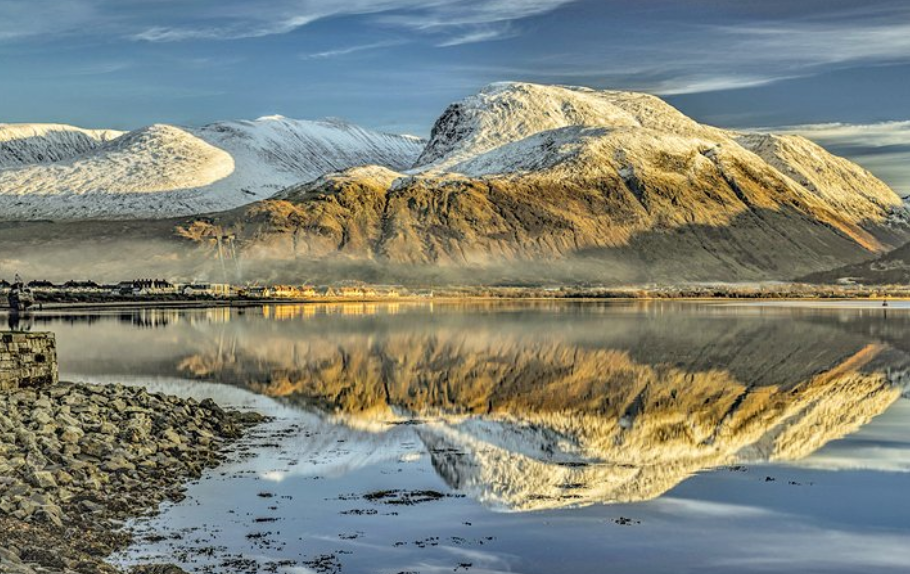
Ben Nevis in Lochaber
"Lochaber is a name applied to
areas of the Scottish Highlands. Historically, it
consisted of the parishes of Kilmallie and
Kilmonivaig,...this Lochaber extended from the Northern
shore of Loch Leven, a district called Nether Lochaber to
beyond Spean Bridge and Roy Bridge, which area is known as
Brae Lochaber or Braigh Loch Abar in Gaelic."
(wikipedia.com)
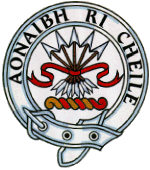
"The Camerons are descended from the ancient Dalriadic kings of the West Coast. An old Irish manuscript lists their ancestry from Ferchar Fada of the tribe of Lorn, king of Dalraida in 697. The Gaelic name was Camshron. The name is from the Gaelic Cam-shorn, meaning hook nose. It is said that a hooked nose was a characteristic of the old Clan Cameron families. Their principal territory was Locheil and Northern Argyll. The Cameron chiefs were distinguished for their warlike tendencies.They were known as fierce fighters: “For centuries the Camerons held by the sword the lands that had once been Clan Chattan’s heritage in Lochaber. Their ferocious war cry was a promise to feed their enemies’ flesh to dogs: “Sons of the hounds come here and get flesh”. Their territory was bounded to the south by the MacLeans, to the west by the MacDonalds. Most of Cameron country is over one thousand feet in altitude. The highest mountain in Britain, Ben Nevis, is included in this area. The area contains eagles, wild cats, foxes, otters and red deer. The last wolf in Scotland is said to have been killed in 1680 by Ewan Cameron of Lochiel.
The earliest historically recorded Cameron laird was Donald Dubh (or Black Donald) mentioned in the fifteenth century. He was a formidable Lochaber warrier, and is considered to be the eleventh chief of Clan Cameron. One of the best known Cameron chiefs was Sir Ewen Cameron, in the late 1600s. He was the last chief to hold out against Cromwell, and bit through a Cromwellian officer’s windpipe while locked in mortal combat near Inverlochy. Despite his ferocity, Ewan was said to be “the very model of a Highland gentleman of those times.” He trained his men to be tough and disciplined, and to say that a bed of snow was like a “thrice-driven bed of down”.He saw one of his nephews had rolled together a large snowball as a pillow for his head. Ewan kicked the heap from under his head, saying “What! Are you become a luxurious that you cannot sleep without a pillow?”
The Camerons fought on the side of Bonnie Prince Charlie in the battle of Culloden: “Donald Cameron of Lochiel was a man on whom the exiled Stewarts rested stronger hopes than on any other chieftain in the Highlands. Individually, he headed a powerful and warlike clan, who so loved him that they would have gone at his lightest word into the very jaws of death. All the Highlands, from end to end, looked up confidingly to Locheil; and though he did his utmost to prevent the rash insurrection of 1745, his final accession to the cause of Charles did more to determine the rising of the Gael generally, than any other influence called into force on the occasion.” The meeting of Prince Charles and Cameron is described: “When Lochiel and the Chevalier met, the former used all the arguments that a man of sound sense and good feeling could do, to prevent the futility and hopelessness, for the time, of the proposed undertaking. He spoke in vain; and at last Charles tauntingly exclaimed, “In a few days I will raise the royal standard. Locheil, whom my father has often spoken of as our warmest friend, may stay at home, and learn from the newspapers the fate of his prince!” “No!” cried Lochiel, in tears, “I will share the fate of my prince, come weal, come wo! And so shall every man over whom nature or fortune has given me power!” On these words, we may almost say, the civil war of 1745 hung.” (Clan Cameron) Lochiel rallied Clan Cameron, and prepared for battle with 700 Camerons following him. The Camerons stood in the front lines at the battle of Culloden. Their fight has been described by eye witnesses: “With their bonnets pulled tightly over their brows, their bodies half-bent, their shields raised so as to cover the head and vital parts, and their broadswords quivering in their nervous gripe, they sprung forward upon their foes like crouching tigers, their eyes gleaming with an expression fierce and terrific to the last degree. In this charge the front rank of the Camerons fell almost to a man.” (www.clan-cameron)
The clan motto is “For king and country”.
The clan war cry is “Sons of the hounds come here and get flesh”.
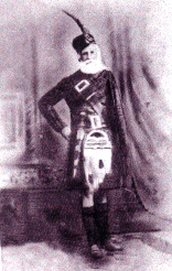
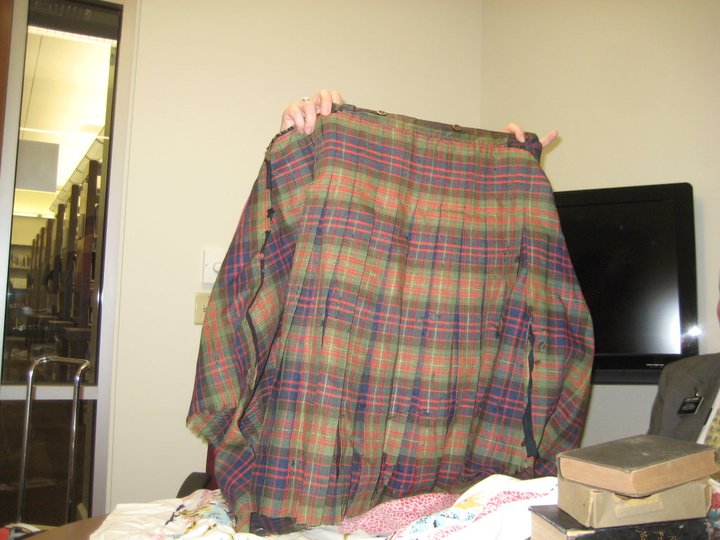
John Alexander Cameron in his kilt, and the same original kilt - Cameron of Erracht
CAMERONS IN BLACK CAIRN
What about the mysterous reference to Black Cairn? There is a cryptic reference in Catherine Cameron's family records to Black Cairn.

(Temple Record Book of Catherine Cameron Southam)
John Alexander Cameron was born in the farm Barachuile in Kilmelford parish. There is no Black Cairn there. The search for the mysterious Black Cairn may have turned up a clue. There is a small bay on Loch Linnhe called Camas a Chairn Dubh - in English, the Bay of the Black Cairn. It is located just south of Kilmalieu, and about five miles from Strontian where Alexander Cameron was born. Perhaps this was a reference to the Cameron's earlier homeland.
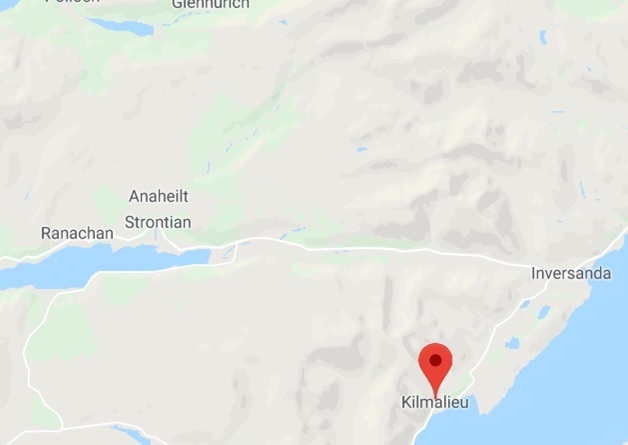
Camas a Chairn Dubh
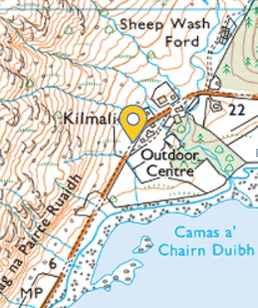
If John Cameron was one of the soldiers listed at Culloden, then he came from Lochaber, Achnacarry, Strone, Fort William, Corran, or Strontian. Most of these locations, along with Kilmalieu (Black Cairn) lie along Loch Linnhe, within about 35 miles of each other.
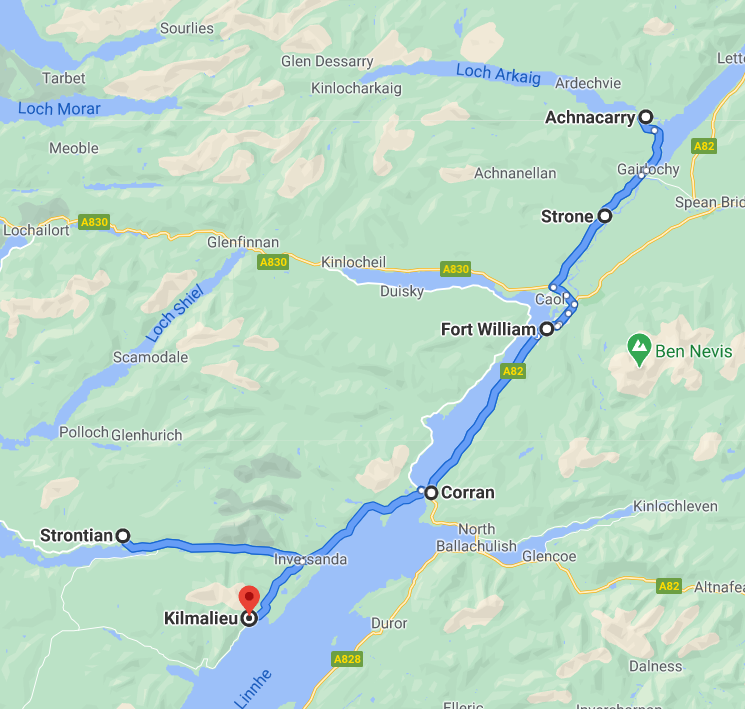
Home of the Camerons

Loch Linnhe
Alexander's father, John Cameron, was shown as being "of Mull" in Cameron family records, and had at least one child (Alexander) born in Strontian. There is also a cryptic reference in family records to Black Cairn. John Cameron is a very common name in that area, and it is hard to identify our John. His wife's name is not known for sure. The names of his children and their birth order is known, but their births pre-date the parish register.
John Cameron born abt. 1769 of Mull
Mrs. John Cameron " " 1771 "
Children:
Donald 1791 of Mull
Peter 1793 "
John 1795 "
*Alexander 1797 "
Thomas 1799 "
Jennet 1801 "
Kirtsey 1803 "
(Temple Record Book of Catherine Cameron Southam, FHS# 218887)
The birth years of John's children are obviously calculated, and spaced about two years apart. They are most likely calculated from Alexander's birth year, as that was known and recorded by his son John Alexander. Alexander's father John's birth year seems to be calculated, too. His wife's birth year was shown as twenty years before the birth of the first child. John's birth year was two years before that, making his calculated birth year 1769 of Mull. He would have been 21 years old at his calculated marriage date of 1790.

Record Book of Catherine Cameron Southam, granddaughter of Alexander Cameron
Scottish
civil registration did not begin until 1855. Church
records on Mull began in about 1790. Scottish censuses
don't begin until 1841. Fortunately, on the Isle of Mull
in 1779 a census was taken of the inhabitants of the Duke
of Argyll's property. The list of inhabitants on the
estates of the Duke of Argyll is one of the earliest
Scottish censuses. The list was created to help John, the
fifth Duke of Argyll manage his estates, which cover most
of Argyllshire. This includes the isle of Mull.
Cameron was not a native Mull name, and most Cameron families appeared in the record after Culloden. "Cameron, like McPhie, was a surname rarely found on Mull or Iona. The name became more common after the Jacobite defeat at Culloden, when several Cameron families who had supported the Jacobite cause moved from their clan area of Lochaber to Mull and Iona.” (The Naked Clansmen on Mull & Iona; Ian McPhee)
Cameron was not a native Mull name, and most Cameron families appeared in the record after Culloden. "Cameron, like McPhie, was a surname rarely found on Mull or Iona. The name became more common after the Jacobite defeat at Culloden, when several Cameron families who had supported the Jacobite cause moved from their clan area of Lochaber to Mull and Iona.” (The Naked Clansmen on Mull & Iona; Ian McPhee)
Only five John Camerons were found on Mull in the 1779 census. Only one had an age close to the calculated age in the Record Book of Catherine Cameron Southam - John Cameron of Auchnacraig, who was eighteen years old, born just eight years before the calculated date. He would have been 29 years old at his calculated marriage date of 1790.
These John Camerons were listed on the 1779 census:
Inhabitants of the Argyll Estate 1779
Knocknafennaig
John Cameron age 64
His wife and daughters, 3
John Cameron junior age 35
His son Hugh 8
His wife
This family in Knocknafenaig is well-documented, and later emigrated to Canada. They had roots in the Mull area, and a John Cameron was listed in Knocknafenaig in 1716. "It is interesting to note the continued presence of another uncommon Mull name at Knocknafenaig. Two Cameron families also resided there. They were descendants of the Cameron who was listed on the 1716 Disarming List at Knocknafeig. John Cameron, 64 lived there with his wife and three year old son." (The Naked Clansman, by Ian McPhee) The three year-old son was named Hugh, and appears in later records. "Most of the Knocknafenaig people left in the 1850s, and again in 1865, for Bruce County Ontario, where Camerons can be identified in the Port Elgin cemetery." (Mull Family Names for Ancestor Hunters; Jo Currie)
Icolmkiln
Angus Cameron tenant age 74
His son John Cameron age 28
His wife, daughter and servant
Neil Cameron tenant age 35
His son Colin Cameron age 6
His wife, daughter and mother 3
This John Cameron was born in 1751, too old to be our John.
Achnacraig
John Cameron age 18
John Cameron age 64
The young John Cameron is the most likely candidate for our John Cameron, He was born in 1761. John lived in the hamlet of Auchnacraig, on the east coast of Mull, near the ferry crossing. The Camerons were not in Auchnacraig in 1716, but appear in time for the 1779 census. Local histories say that they were likely from the Cameron lands in Lochaber in the years after the Jacobite rebellion in 1745-6. This John did not stay and marry and have children in Mull. The little hamlet of Auchnacraig was in the parish of Torosay. The only other Cameron in the hamlet was another John Cameron, age 64, who is likely John's father. The senior John would have been born in 1715. This would have made him about thirty years old at the time of the Jacobite rebellion, and of an age to have fought with the Camerons. This is in agreement with the statement on the Camerons in Mull: ""Cameron, like McPhie, was a surname rarely found on Mull or Iona. The name became more common after the Jacobite defeat at Culloden, when several Cameron families who had supported the Jacobite cause moved from their clan area of Lochaber to Mull and Iona.” There is a family tradition that the knife (sgian dhu) John Alexander Cameron brought with him to America was used in the battle of Culloden in 1746. Was it his great-grandfather John Cameron's knife? After Culloden many Camerons lost their land. Their clan chief Cameron of Lochiel did not regain his land until 1784. Perhaps John senior was driven from his home after Culloden, and came to Mull, where his son John was born in 1761.

Map of the Isle of Mull, with the red arrow showing the location of Auchnacraig

Auchnacraig
FAMILY GROUP RECORD OF
JOHN CAMERON (the younger)
JOHN CAMERON (the younger)
John Cameron was born in Mull, most likely in 1761 in Auchnacraig, Torosay parish, Isle of Mull, Scotland, the son of John Cameron. He moved to Strontian, Argyllshire by 1797, probably to work in the lead mines.

Mull cottage
Auchnacraig was a hamlet near the ferry from the mainland: "The ferry from Achnacraig to Mull to Kerrera belonged to the Duke (of Argyll) and was in tack to Angus Gregorson or MacGregor, who enjoyed a monopoloy of the transport of cattle to the mainland. The Duke’s tenants in Mull were obliged by their leases to use the ferry." The tacksman in charge of the farm at Auchnacraig was John Gregorson: "Perhaps the most characteristic figure is John Gregorson, who had a tack of Auchnacraig and Ardchyle in Mull, with the inn at Auchnacraig, in the 3rd and 4th Dukes’ time. He acquired ‘the exclusive privilege to ferry cattell and passengers from Torosay to the continent of Lorn'. His brother Angus succeeded him in this tack and his monopoly of the ferry. (Book of Mull and Morvern Tacks, 1770-1776; Remarks on the Estate of Mull and Morvern, unsigned report, dated 1771, at Inveraray Castle) In this location, John and his son John likely farmed the land, worked with the ferry, or fished for a living. Auchnacraig is mentioned as a farm in letters from the Duke of Argyll: "The improvements executed upon the farms of Achnacraig, Achadashinaig, Fidden and Ardtorinish in terms of the tacksmen’s prorogated leased, have been inspected by the chamberlain and a relative report of the state of their progress is herewith laid before my Lord Duke." (Book of Mull and Morvern Tacks) The Duke of Argyll was the landowner for a large part of Argyllshire, including Mull and Morvern, with Strontian, Sunart and Ardnamurchan included. He left careful instructions for the stewards in all of his estates, which includes some mention of its tenants. John Cameron's ancestors of Mull and Strontian were likely his tenants.
Auchnacraig was a small hamlet, and the 1779 census listed 84 inhabitants.
Dugald McLachlan, age 56
James Bonnar, age 20
Hugh McLachlan, age 22
John McLachlan, age 16
Robert McLachlan age 14
Alan McLachlan, age 11
Alexr McLachlan, age 12
John McGregor, age 20, ferryman
Allan McDonald, age 30
Donald McLachlan, age 28
Angus McLachlan, age 22, servant
Donald McLugas, 10
Dugald McLachlan, age 9
Dugald McLachlan, age 10
Archibald McLugas, age 35
John McLugas, age 8
John Carmichael, age 20
John McLachlan, age 32
John Cameron, age 18
Duncan McLachlan, age 3
Andrew McLachlan, age 0
John Cameron, age 64
John Fletcher, age 50
Lachlan McLachlan, age 58
Hugh McLachlan, age 15
Archibald McLucash, age 45
Duncan McLucash, age 6
Archibald McLucash, age 4
Donald McLucash, age 2
John McGrigor, age 50
Angus Fletcher, age 8
John McLachlan, age 25
John Colquhoun, age 7
50 females
Only the males were listed in the census by name. There were seven different surnames listed, and probably about ten households. The women and girls were only listed as a total number of 50 females. All males were listed by name, including children. There were 19 adult males of 16 years or older. Occupations were only listed for two of the men - a ferryman and a servant. The others may have been farming or fishing. Only one McDonald had been listed in the earlier 1716 census in Auchnacraig, with one McLugash in the nearby hamlet of Glennan. The other families were not there at that time, and may have come later. The families listed in Auchnacraig in 1716 were McDugald, Lamont, McLean, McIlvorie, McDonald, McInnish, McChannanich, McKiachan, and McLea.

Map of the Auchnacraig estate, showing the hamlet of Auchnacraig on the coast
Unfortunately John's mother was not named on the list. One other Cameron was listed as being of Auchnacraig in later baptism records - Catherine Cameron of Auchnacraig who married Lachlan McLachlan, and had ten children baptised in the parish, beginning in 1794. She is likely a sister to John Cameron.

Ferry Cottage at Grass Point near Auchnacraig
What happened to young John Cameron? There is no record of his marriage or baptisms of children in the Torosay parish register. We know that our John Cameron of Mull, must have left the island, and his son Alexander was born in Strontian on the mainland in 1797. Strontian was a lead mining village. The economy on Mull was challenging, and John may have moved to Strontian to work in the lead mines. No record was found for his children's baptisms in Mull where the parish records began in 1790, and the Strontian parish registers don't begin until 1804, so the children were probably born in Strontian starting in 1791 and continuing until 1803. Alexander Cameron identified Strontian as his birthplace on the 1861 census.

Map of Strontian parish
Separate parish registers exist for Strontian beginning in 1804. Ardnamurchan parish registers exist from 1777, but are blank from January 1779 to May 1802, and April 1809 to May 1810. No burials are recorded in the early parish registers, but baptisms and marriages are recorded. John Cameron's last child was Kirtsey, born about 1803, one year before the Strontian parish register begins. There were a large number of Camerons in Strontian. For example, in 1806, there were 31 baptisms listed in the Strontian parish register. Of these 19 (or 61%) were children born to Cameron fathers. There are 16 different John Cameron families in Strontian having children baptized between 1804 and 1810. After an exhaustive search, no baptismal records have been found that closely match John Cameron's family. To review the parish registers results, click here: Cameron Research.

Strontian
Strontian is a village and parish in highland Scotland, in the county of Argyllshire, The main industry in the parish was lead mining, which began in 1725. In these mines the mineral strontianite was discoved. The community was built out to provide housing for the lead miners. In 1871, the population of Strontian was 803. Anaheilt, Ramachan, and Scotstown are hamlets and considered part of Strontian. Anaheilt had eight families in 1723, which had grown to 28 crofts by 1828. Many of the families of Strontian were Camerons, and most worked in the lead mines.

Strontian mine
John and his wife had the following children, most likely born in Strontian before 1804:
1. Donald, born in about 1791in Strontian.
2. Peter, born in about 1793 in Strontian.
3. John, born in about 1795 in Stontian.
*4. Alexander, born in 1797 in Strontian, Argyllshire, Scotland; married Catherine MacCallum 9 December 1813 in Kilmelford, Argyllshire.
5. Thomas, born in about 1799 of Strontian.
6. Jennet, born in about 1801 of Strontian.
7. Kirtsey, born in about 1803 of Strontian.
SOURCES: Catherine Cameron Southam, Temple Record Book; 1861 Scottish census, Inveraray; Inhabitants of the Argyll Estate 1799; The Naked Clansmen on Mull & Iona, by Ian McPhee; Strontian parish register.
FAMILY GROUP RECORD OF
JOHN CAMERON (the elder)
JOHN CAMERON (the elder)
John Cameron was born in about 1715. Local histories of Mull suggest that he was one of the Camerons who came to Mull after the Jacobite rebellion (about 1746). John may have come from the Cameron lands of Lochaber in norther Argyllshire and Inverness-shire, or from the lands of Ardnamurchan, Sunart and Morvern in Argyllshire. According to clancameron.org, Clan Cameron Cadet Families: “The Camerons of Ardnamurchan, along with the Camerons of Sunart and Morvern, these Camerons are descended from Donald na Cuirc Cameron of Glendessary, son of Allan M’Illduy of Lochiel and other affiliated Camerons, who in or about 1650 secured tacks of large areas in these districts and “colonized” them with Cameron clansmen. In addition to Camerons there were also a fair number of MacMillans, MacPhees and MacLachlans.” It is interesting that the MacLachlans were so well-represented in Auchnacraig, and the McPhees are also found on Mull.

Lochaber, home of the Camerons

Map of Lochaber
These fifteen John Camerons fought in the Battle of Culloden. Of these, five died or were transported, so could not be our John Cameron. If he did fight in Culloden, he could be one of these ten remaining John Camerons.
Soldiers
in Donald Cameron of Lochiel's Regiment
in 1745
Captains
John Cameron, excaped
Officers
John Cameron (Argyll), brother to Callart, died of wounds at Culloden
John Cameron (Chelsea Pensioner), uncle to Reverend John, escaped
Chaplains
Rev. John Cameron (Fort William, Church of Scotland Minister),Reverend, Fort William, Church of Scotland
Sergeants
John Cameron (Corpach, Brewer)
Private men
John Cameron (Lochaber, Labourer), surrendered 24 May 1746
John Cameron (Lochaber, Labourer, 70), taken at Carlisle, transported
John Cameron (Lochaber, Labourer, 60), taken at Carlisle, transported
John Cameron (Auchnacarry, Lochaber), surrendered 24 May 1746
John Cameron (Argyllshire), wounded at Prestonpans, taken prisoner, died
John Cameron Rae (Lochaber), surrendered 24 May 1746
John Cameron (Corran, Lochaber)
John Cameron (Lochaber, Labourer, 33), deserted, taken 6 November 1745, transported
John Cameron (Stroan, Lochaber), surrendered 24 May 1746
John Cameron (Strontian, Whisky maker), deserted, pardoned 1747: Cameron, John, from Strontian, imprisoned Edinburgh Tolbooth, released under General Pardon, 1747, "A whiskie maker in Strontian. Confesses that he marched with the rebels to Lauder and made his escape from there. Denies he carried arms.
(SOURCES: No Quarter Given, edited by Alastair Livingstone, Christian W.H. Aikman, and Berry Stuart Hart; Jacobite Rebellion of 1745, Regimental Lists, jacobites.net; https://military.wikia.org/wiki/Donald_Cameron_of_Lochiel; Highland Jacobites, Frances McDonnell)
"The Camerons, Stewarts of Appin and the Athollmen made up the right flank's first line. The men of Atholl were positioned on the far right "with their flank resting on the dry-stone wall of the Culwhinia enclosure." Between them and the Stewarts was Lochiel's regiment. A reported 700 men, mainly from Lochaber, were there in Lochiel's formation, mostly consisting of Camerons but also known to include a few men from at least the following clans and septs: Fraser, Grants, MacDonald, MacDougall, MacHoule, MacKenzie, MacLachlan, MacLeod, MacMartin, MacMillan, MacNeill, MacOllonie, MacPhee and even a few men from Clan Campbell. Nevertheless, this was a Clan Cameron regiment, accompanied by their septs and various tenants from Lochiel's estate...Before each clan stood the chief...With him were his henchmen and his piper, and a small bodyguard formed by two of the best men from each company of the clan. With the companies in line, captained by cadets of the chieftain's family, or by chiefs of smaller septs, were two lieutenants and two ensigns, and they, too, were chief's sons or the sons of sons. The first ranks of each company consisted of men who may have held land or had no land at all, but who were, in the geology of their society, placed among the strata of gentlemen...Behind them stood those with lesser claims to gentility, and behind again yet another rank, so that in some clans the ranks were six deep. In the rear of all stood the wild and bearded humblies...But these common men, disposed themselves by families, brothers and sons about the father, for it was in the tradition of their hills that the oldest and most respected should stand closest to the enemy, and that inspiration and courage should pass through father, brother, son, tenant and servant." (www.clan-cameron.org)

The defeated Highlanders returned to Locaber or the mountains: "Many of the Highlanders headed for Inverness and were hunted down and killed without mercy by Cumberland's dragoons. Others, who headed into the mountains, stood a better chance of survival, but the government troops were thorough in their retribution." (Culloden, www.bbc.co.uk)
"While Charles made his escape the full force of the Government's revenge fell upon the Highlands. After the battle wounded clansmen were put to death on Cumberland's order, which is why he acquired the nickname of 'Butcher'. Several hundred more were cut down and killed on the retreat to Inverness, and these included bystanders. Finally, the town itself was thoroughly searched and people suspected of being concerned in the rebellion were killed on the spot...The decision was taken to crush the power of the Highlanders and destroy their traditional way of living. Bland, who was a major-general in Cumberland's army, was in favour of a tough military ...Cumberland's soldiers were happy to carry out the orders of their officers in the summer of 1746, especially since it was so easy and they met little resistance. As the soldiers marched through the Great Glen they burned the huts and crofts of the clansmen and the houses of the chiefs, and committed many atrocities. The Highlanders who were captured were shipped off to the colonies like slaves, and those left found it hard to survive, because they relied on their cattle for food, and it was policy to take these. In the Highlands the '45 was also a civil war with members of several clans taking part on both sides, but military policy did not distinguish very easily between the innocent and the guilty. There were also quite difficult problems of knowing whom to punish. The Duke of Argyll was one of the government's most powerful supporters, yet his tenants in Morven were either Camerons or Macleans and most of the men had been in the Jacobite army. Morven was laid waste, and the Duke of Argyll suffered a considerable loss of revenue, for which the government was not anxious to compensate him. This sort of action fitted in well with Cumberland's belief that all Scots were rebels and traitors...The property of those who had joined the rebellion was confiscated, and the 'Forfeited Estates' were administered directly by the government in pursuit of a policy of breaking up the Highlanders' way of life. The political, military and judicial power of the clan chiefs was abolished. The Highlanders were forbidden on pain of death from wearing a tartan plaid (the kilt is the more modern equivalent), bear arms, or carry a dirk or dagger." (Treatment of the Highlanders, University of Nottingham)

John Alexander Cameron's knife
Family tradition is that the knife was used in the Batlle of Culloden.
John Cameron senior was John Alexander Cameron's great-grandson.
A letter from Lord Albemarle discusses the problem of hidden weapons in 1746-7:“The common people such as are herried and their cattle driven, especially among the Cameron, Clanronalds, Glengarys and Glen Morisons, are all ready to espouse the smallest opportunity to appear in Arms again, and for that purpose have certainly concealed some Arms, tho’ the number cannot be determined.” *The Albemarle Papers - Being the Correspondence of William Anne, Second Earl of Albemarle, Commander in Chief in Scotland, 1746-7)
If the 31-year-old John Cameron did fight in and survive the battle of Culloden, he may have been in hiding in the years after the battle. He likely lost friends and family, and his home. His wealth, usually in cattle, would have been confiscated. Did he have a family? His clan chief was in exile. How did he manage to survive from 1746 until 1761 when his son was born in a small hamlet in Mull, some fifteen years later?

Memorial stone for the Camerons at Culloden
After Culloden, "The once extensive lands of the Camerons have shrunk to little more than a single farm. The MacLeans, politically not so suspect as the Camerons, retain the wide Broloss lands, but have lost a number of their farms...The Camerons did not lose their fierce, fighting spirit: In critical times, the northern districts were as much a handicap as an asset, whilst in normal times the dispossessed Camerons plundered and terrorised the tacksmen in Morvern, and Campbell of Airds, when collecting the rents, never ventured there without an armed posse." (Argyll Estate Instructions: Mull, Morvern, Tiree, 1771-1805, edited by Eric R.. Cregeen, Scottish History Society, 1964.)
In
a letter from Donald Campbell of Airds to the Lord Justice
Clerk of Scotland in 1746, he proposed a "Scheme
for Civilizing the Clan Cameron":
Edinburgh - October 3, 1746
To distress the Clan Cameron and oblidge them to a Complyance with the present Laws against carrying of Arms, and wearing of Highland Cloathes, a Military force will be necessary.
For this purpose, and apprehending such Rebell Gentlemen as are lurking in Lochels Country, and preventing their making Depredations on their Neighbours who are Loyal Subjects, it is judged 430 men will be necessary, and to be stationed as follows:
100 at Strontian - accommodation (exists) for 200.
70 Head of Locheyll - but indifferent Quarters. Distant from Strontian 9 miles.
100 Head of Locherkaig - requires a Strong Party as Bordering on Knoydart and the McDonalds Country - bad accommodation. Distant from the head of Locheyll 6 miles.
50 Locheyls House at Achnacarry. Distant from head of Locherkaig 12 miles.
50 Highbridge - indifferent accommodation. Distant from Achnacarry 4 miles.
60 Kinlochbeg and Achtrichedan in Glencoe. Tolerable accommodation. Distant from Highbridge 12 miles.
-----------------
430
The above scheme given in by Donald Campbell of Airds to the Right Hon. the Earl of Albemarl, and the Right Hon. the Lord Justice Clerk.
[Signed] Donald Campbell
How did John Cameron come to Mull? "After the initial swift and bloodthirsty retribution for the Jacobite rebellions, laws were instigated to prevent any further groundswell of support for the previous monarchs. In 1747 ‘The Act of Proscription’ was passed. Clan tartan had become popular during the Jacobite years and this was outlawed under this new act, as were bagpipes and the teaching of Gaelic. The Act was a direct attack on the highland culture and way of life, and attempted to eradicate it from a modern and Hanoverian-loyal Scotland. It was not only highland culture that disappeared over this period but also the highlanders themselves, for the most prosaic of reasons: money. It was deduced by those landowners on whose lands the clans lived and worked, that sheep were exponentially more financially productive than people. The wool trade had begun to boom and there was literally more value in sheep than people. So, what followed was an organized and intentional removal of the population from the area. In 1747, another Act was passed, the ‘Heritable Jurisdictions Act’, which stated that anyone who did not submit to English rule automatically forfeited their land: bend the knee or surrender your birth right. Some highlander clans and families had lived in the same cottages for 500 years and then, just like that, they were gone. People were literally turned out of their cottages into the surrounding countryside. Many were relocated to the coast where they would subsist farm almost cultivatable land, supplementing themselves by smelting kelp and fishing. However the kelp industry also began to decline. Some were put on to different land to farm crops, but they had no legal rights to the land. It was a very feudal arrangement." (The Highland Clearances, historic-uk.com)
At some point, John came to Mull for refuge. John was found in Auchnacraig in 1779, at the age of 64, with young John Cameron, age 18, who is likely his son. No other Camerons were listed in the hamlet. Women were not listed by name. Catherine Cameron "of Auchnacraig" is found in the early baptism registers in Torosay parish, married to Lachlan McLachlan. She may be John's daughter. No burials are recorded in the Torosay parish register, so no death record is found for John or his wife.
This family group is speculative:
John and his wife had the following children:
*1. John, born in about 1761 of Mull.
2. Catherine, born in about 1770 of Mull; married Lachlan MacLachlan; had children Allan (1794), Marrion (1795), Angus (1797, Allan (1799), Robert (1799), Allan (1801), Flory (1803), Mary (1805), John (1807), and Janet (1809), all baptized in Torosay parish.
SOURCES: Torosay parish register; Inhabitants of the Argyll Estate 1799; Argyll Estate Instructions; The Naked Clansmen on Mull & Iona, by Ian McPhee; Mull, The Island & Its People, by Jo Currie; Mull Family Names for Ancestor Hunters; Jo Currie; Jacobite Rebellion of 1745, Regimental Lists, jacobites.net; https://military.wikia.org/wiki/Donald_Cameron_of_Lochiel.
THE CAMERONS OF LOCHABER

Ben Nevis in Lochaber

"The Camerons are descended from the ancient Dalriadic kings of the West Coast. An old Irish manuscript lists their ancestry from Ferchar Fada of the tribe of Lorn, king of Dalraida in 697. The Gaelic name was Camshron. The name is from the Gaelic Cam-shorn, meaning hook nose. It is said that a hooked nose was a characteristic of the old Clan Cameron families. Their principal territory was Locheil and Northern Argyll. The Cameron chiefs were distinguished for their warlike tendencies.They were known as fierce fighters: “For centuries the Camerons held by the sword the lands that had once been Clan Chattan’s heritage in Lochaber. Their ferocious war cry was a promise to feed their enemies’ flesh to dogs: “Sons of the hounds come here and get flesh”. Their territory was bounded to the south by the MacLeans, to the west by the MacDonalds. Most of Cameron country is over one thousand feet in altitude. The highest mountain in Britain, Ben Nevis, is included in this area. The area contains eagles, wild cats, foxes, otters and red deer. The last wolf in Scotland is said to have been killed in 1680 by Ewan Cameron of Lochiel.
The earliest historically recorded Cameron laird was Donald Dubh (or Black Donald) mentioned in the fifteenth century. He was a formidable Lochaber warrier, and is considered to be the eleventh chief of Clan Cameron. One of the best known Cameron chiefs was Sir Ewen Cameron, in the late 1600s. He was the last chief to hold out against Cromwell, and bit through a Cromwellian officer’s windpipe while locked in mortal combat near Inverlochy. Despite his ferocity, Ewan was said to be “the very model of a Highland gentleman of those times.” He trained his men to be tough and disciplined, and to say that a bed of snow was like a “thrice-driven bed of down”.He saw one of his nephews had rolled together a large snowball as a pillow for his head. Ewan kicked the heap from under his head, saying “What! Are you become a luxurious that you cannot sleep without a pillow?”
The Camerons fought on the side of Bonnie Prince Charlie in the battle of Culloden: “Donald Cameron of Lochiel was a man on whom the exiled Stewarts rested stronger hopes than on any other chieftain in the Highlands. Individually, he headed a powerful and warlike clan, who so loved him that they would have gone at his lightest word into the very jaws of death. All the Highlands, from end to end, looked up confidingly to Locheil; and though he did his utmost to prevent the rash insurrection of 1745, his final accession to the cause of Charles did more to determine the rising of the Gael generally, than any other influence called into force on the occasion.” The meeting of Prince Charles and Cameron is described: “When Lochiel and the Chevalier met, the former used all the arguments that a man of sound sense and good feeling could do, to prevent the futility and hopelessness, for the time, of the proposed undertaking. He spoke in vain; and at last Charles tauntingly exclaimed, “In a few days I will raise the royal standard. Locheil, whom my father has often spoken of as our warmest friend, may stay at home, and learn from the newspapers the fate of his prince!” “No!” cried Lochiel, in tears, “I will share the fate of my prince, come weal, come wo! And so shall every man over whom nature or fortune has given me power!” On these words, we may almost say, the civil war of 1745 hung.” (Clan Cameron) Lochiel rallied Clan Cameron, and prepared for battle with 700 Camerons following him. The Camerons stood in the front lines at the battle of Culloden. Their fight has been described by eye witnesses: “With their bonnets pulled tightly over their brows, their bodies half-bent, their shields raised so as to cover the head and vital parts, and their broadswords quivering in their nervous gripe, they sprung forward upon their foes like crouching tigers, their eyes gleaming with an expression fierce and terrific to the last degree. In this charge the front rank of the Camerons fell almost to a man.” (www.clan-cameron)
The clan motto is “For king and country”.
The clan war cry is “Sons of the hounds come here and get flesh”.


John Alexander Cameron in his kilt, and the same original kilt - Cameron of Erracht
CAMERONS IN BLACK CAIRN
What about the mysterous reference to Black Cairn? There is a cryptic reference in Catherine Cameron's family records to Black Cairn.

(Temple Record Book of Catherine Cameron Southam)
John Alexander Cameron was born in the farm Barachuile in Kilmelford parish. There is no Black Cairn there. The search for the mysterious Black Cairn may have turned up a clue. There is a small bay on Loch Linnhe called Camas a Chairn Dubh - in English, the Bay of the Black Cairn. It is located just south of Kilmalieu, and about five miles from Strontian where Alexander Cameron was born. Perhaps this was a reference to the Cameron's earlier homeland.

Camas a Chairn Dubh

If John Cameron was one of the soldiers listed at Culloden, then he came from Lochaber, Achnacarry, Strone, Fort William, Corran, or Strontian. Most of these locations, along with Kilmalieu (Black Cairn) lie along Loch Linnhe, within about 35 miles of each other.

Home of the Camerons

Loch Linnhe